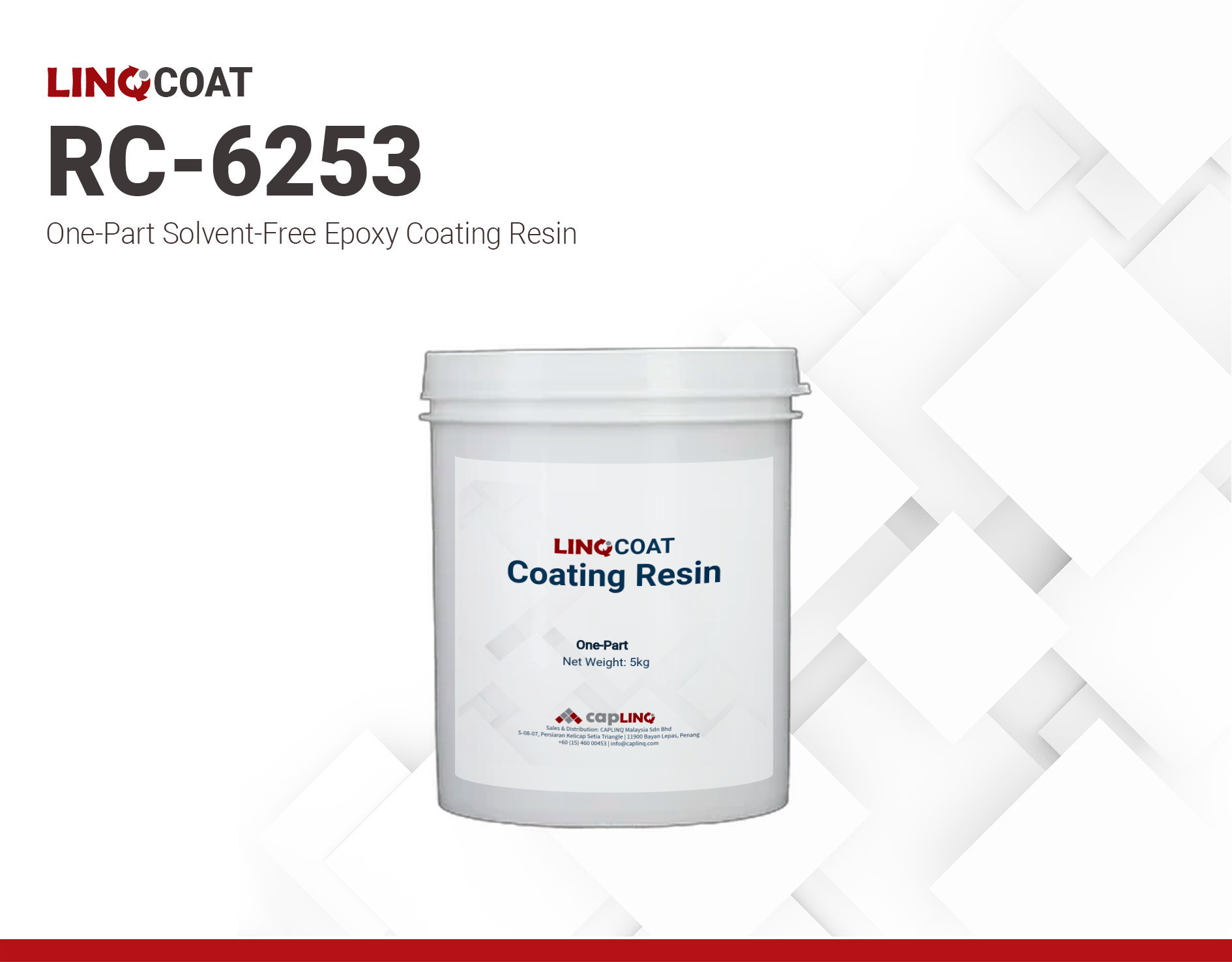RC-6253 | One-Part Epoxy Coating Resin
Harmonization Code : 3208.20.90 | Paints and varnishes that are dispersed or dissolved in a non aqueous medium
Main features
- Thermally stable polymer (140 °C Tg)
- 14-day pot life
- Low moisture absorption
Product Description
LINQCOAT RC-6253 is a solvent-free epoxy resin engineered for use as an impregnation and protective coating material for electronics assemblies. Once cured, it forms a high-gloss, Shore-D 87 network that delivers >25 kV mm⁻¹ dielectric strength, resists moisture uptake (0.1 %), and retains mechanical integrity from −20 to 180 °C.
LINQCOAT RC-6253 offers a combination of electrical insulation, corrosion protection, and weather resistance, making it a robust, high-performance material for motors, sensors, and outdoor electronics operating in harsh environments. It also meets the requirements of the 2011/65/EU RoHS directive.
Product Key Features
- High Glass Transition Temperature (140 °C) — Maintains its hard, glassy state and structural integrity at elevated temperatures.
- 14-day Pot Life — Provides extended working time, allowing for easier application, especially for larger or more complex assemblies
- High Dielectric Strength (>25 kV mm⁻¹) — Superior electrical insulation.
- Excellent Moisture Resistance — Absorbs only 0.1% moisture, protecting components from humidity.
Applications
- Provides robust protection and electrical insulation in demanding motor applications.
- Ensures high-performance and longevity for electronics operating in harsh outdoor environments, including those exposed to wide temperature swings and moisture.
Technical Specifications
| General Properties | |
| Appearance Appearance Appearance at room temperature. | Opaque Liquid |
| Pot Life Pot Life Pot life is the amount of time it takes for the viscosity of a material to double (or quadruple for lower viscosity materials) in room temperature after a material is mixed. It is closely related to work life but it is not application dependent, less precise and more of a general indication of how fast a system is going to cure. | 336 hours |
| Specific Gravity Specific Gravity Specific gravity (SG) is the ratio of the density of a substance to the density of a reference substance; equivalently, it is the ratio of the mass of a substance to the mass of a reference substance for the same given volume. For liquids, the reference substance is almost always water (1), while for gases, it is air (1.18) at room temperature. Specific gravity is unitless. | 1.23 |
| Thermal Properties | |
| Glass Transition Temperature (Tg) Glass Transition Temperature (Tg) The glass transition temperature for organic adhesives is a temperature region where the polymers change from glassy and brittle to soft and rubbery. Increasing the temperature further continues the softening process as the viscosity drops too. Temperatures between the glass transition temperature and below the decomposition point of the adhesive are the best region for bonding. The glass-transition temperature Tg of a material characterizes the range of temperatures over which this glass transition occurs. | 140 °C |
| Operating Temperature | -20 - 180 °C |
| Electrical Properties | |
| Dielectric Strength Dielectric Strength Dielectric strength is measured in kV per mm and is calculated by the Breakdown voltage divided by the thickness of the tested material. Those two properties go hand in hand and while Breakdown voltage is always thickness dependent, dielectric strength is a general material property. As an example, the dielectric strength of Polyimide is 236 kV/mm. If we place 1mm of Polyimide between two electrodes, it will act as an insulator until the voltage between the electrodes reaches 236 kV. At this point it will start acting as a good conductor, causing sparks, potential punctures and current flow. | 25 kV/mm |
| Surface Resistivity | 2.3e14 Ohms/sq |
| Volume Resistivity Volume Resistivity Volume resistivity, also called volume resistance, bulk resistance or bulk resistivity is a thickness dependent measurement of the resistivity of a material perpendicular to the plane of the surface. | 5.2x1015 Ohms⋅cm |
| Chemical Properties | |
| Water Absorption | 0.1 % |
| Physical Properties | |
| Viscosity Viscosity Viscosity is a measurement of a fluid’s resistance to flow. Viscosity is commonly measured in centiPoise (cP). One cP is defined as the viscosity of water and all other viscosities are derived from this base. MPa is another common unit with a 1:1 conversion to cP. A product like honey would have a much higher viscosity -around 10,000 cPs- compared to water. As a result, honey would flow much slower out of a tipped glass than water would. The viscosity of a material can be decreased with an increase in temperature in order to better suit an application | 500–1500 mPa.s |
Additional Information
Directions for Use
- LINQCOAT RC-6253 can be applied by dipping, brushing, or other standard coating techniques.
- LINQCOAT RC-6253 should be stored at 2–13 °C. Before use, keep the sealed container at ambient conditions for 1–2 hours. Do not open the lid until the temperature has equalised to prevent moisture condensation.
- Ensure that the surfaces where RC-6253 will be applied are clean, dry, and free of grease, dust, and mold-release agents. A simple solvent wipe is usually sufficient.
- Use the product before pot life for optimum properties. Avoid large quantity dispensing without using.
- Reseal the container immediately after dispensing to minimise moisture uptake and maintain product performance.
- Wear appropriate protective equipment and minimize direct contact with the human body. Refer to the Safety Data Sheet (SDS) before use.



